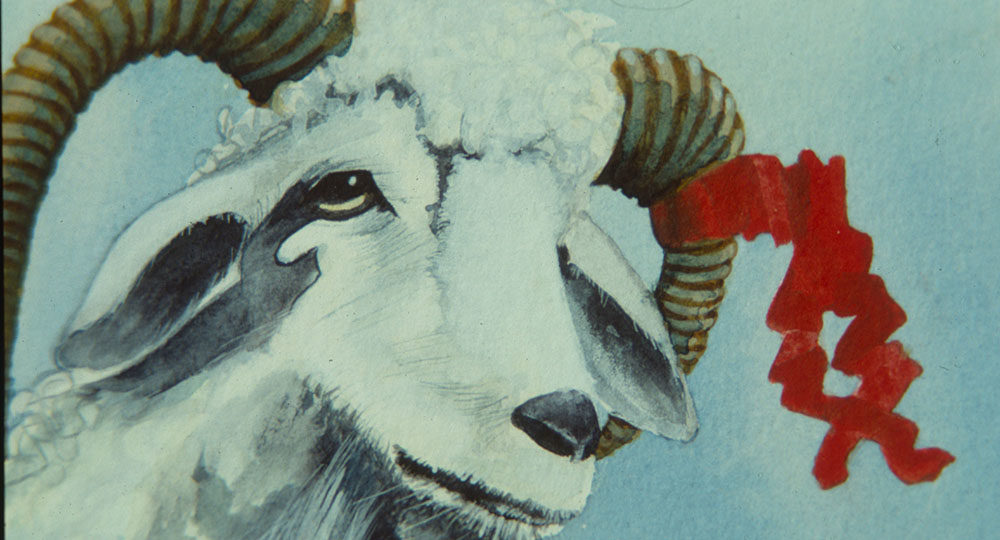
On the Uses and Abuses of Scapegoating

As Yom Kippur approaches, it is worth revisiting the ancient practice of scapegoating. The origins of the ritual provide a critical framework for understanding how Judaism addresses a universal human dilemma: what to do with the burdens and obstacles we cannot possibly hope to confront alone.
The first recorded use of the word “scapegoat” appears in the sixteenth-century translation of the Old Testament by the Bible scholar William Tyndale—an endeavour completed after his death by his colleague Myles Coverdale—in what is now collectively known as the Tyndale Bible.1 The Jewish ritual of scapegoating, described in Leviticus 16, is set within God’s instructions to Moses regarding the duties of his brother Aaron, the High Priest, on Yom Kippur. Aaron was permitted to enter the Holy of Holies—the innermost sanctum of the Mishkan (Tabernacle, the portable precursor to the Jerusalem Temple)—only on this day, and only for sacrificial purposes; to enter at any other time or for any other reason would mean death.
After immersing in a ritual bath, Aaron was instructed to don sacred vestments made almost entirely of linen. From the Israelite community he was to receive two male goats as a sin offering. He then brought both goats to the Nicanor Gate on the eastern side of the Temple courtyard. Aligned directly with the Holy of Holies, this gate allowed the goats to stand “before the Lord” symbolically—facing the innermost sanctum while remaining outside.2
Aaron would then cast lots over the two goats, placing one to his right and the other to his left. This may seem unusual, yet in Jewish tradition the casting of lots is itself bound to divine providence, as Proverbs teaches: “One may cast lots into his lap, but the Lord determines how they fall.”3 Aaron would put both hands into an urn, drawing one lot with his right hand and the other with his left, and he would place them upon the goats—one lot upon each.
This lottery would be conducted before the entire assembly of Israel, who waited with bated breath, caught between curiosity and apprehension, for the divine verdict. The goat upon which the lot inscribed L’Adonai (“For the Lord”) fell he would sacrifice to God. The goat upon which the lot inscribed L’Azazel (“For Azazel”) fell he would designate to be sent into the desolate, rocky wilderness—a fate of certain death. Before this was done, Aaron would confess over the goat all the sins of the Israelites—whether disclosed or concealed, perceived or unperceived. According to rabbinic tradition, a red thread was tied to its horns. Before it was sent off, half of the thread was cut; if the offering had been accepted, the remaining thread would miraculously turn white.4 Through this ritual, the community’s transgressions were placed within the animal, granting them release from their spiritual burdens and the chance to begin anew.
The practice is explained by the medieval scholar and theologian Maimonides: ‘None would seriously contend that sins are material entities, passed tangibly from the back of one person to another. Rather, these rites are allegories, designed to impress upon the soul a certain form, so as to awaken within it the movement of repentance. The intent is that we divest ourselves of our former deeds, cast them behind us, and banish them to the furthest remove.’5
Strange as this ritual may seem—even to those firmly grounded in Judaism’s monotheistic principles—it served a unique purpose. The Yom Kippur service differed in one crucial respect: in every other instance, sins were confessed over the animal that was to be sacrificed. On Yom Kippur, however, the High Priest confessed the sins of the people over the animal that was not sacrificed. And while the scapegoat was doomed to die in the wilderness anyway, it could never be regarded as fit for sanctification.
Today, in the absence of the Temple in Jerusalem, the physical ritual of scapegoating has vanished from Jewish practice—perhaps to the quiet satisfaction of modern animal rights activists. Yet countless healthy alternatives have emerged. Across the world, individuals devise ritualised ways of releasing what weighs them down. From burn rituals, in which written lists of grievances are surrendered to the flames, to breathwork sessions that use the exhale as a means of casting out inner burdens, human beings continue to invent practices that echo the ancient scapegoat dynamic.
Yet the very ritualised patterns once sanctified by Jewish monotheism are often twisted and inverted—turned into weapons against new totems of unpopularity, above all the Jews themselves. Antisemitism thrives on this paradoxical blame-shifting. The Jew is imagined as both powerless and omnipotent: a member of an inferior race that somehow controls the world; a die-hard capitalist secretly advancing Communist revolution; a racist supremacist at the forefront of progressive causes; a miserly bureaucrat who nevertheless owns every bank; and a supposed genocidal conspirator presiding over the Middle East’s only true democracy. Such contradictions betray not logic but an unrelenting need to assign blame, at the expense of critical thought itself.
In our time, the Jew is recast as Azazel. In truth, so is anyone who dares dissent from the dogmas of the modern age—an age that demands we hate those who differ from us in the slightest, that we project our frustrations onto them, that we retreat into “safe spaces” to avoid them, and that we demonise them whenever opportunity arises. Difference itself has become the measure of guilt, the criterion for deciding which proverbial goat must be driven to the cliff’s edge and cast down, never to return.
It is a symptom of our age that we have been taught to think of opposites in distorted and shallow terms. Take, for instance, the common claim—often drilled into us at school—that the opposite of hatred is love. This is not so. Love arises from the recognition of one’s own suffering and aspirations in the other, a capacity that allows for a shared bond in which joy and sorrow are mutually experienced. Hatred, too, presupposes a relationship—however fragile, hostile, or chaotic—between subject and object. The true opposite of hatred, then, is not love but introspection: the recognition that our burdens cannot be lightened by casting our anger, insecurity, or inadequacy onto others, but only by broadening our own shoulders to bear them.
To confront oneself—to search for iniquity and the need for change within one’s own soul—is the bravest task a human being can undertake. As we approach the holiest day of the Jewish calendar, let us all reclaim the wisdom of healthy scapegoating: a collection of practices that turn grievance into growth, rather than distorting blame into cruelty.
References
[1] Originally rendered “scapegoote” in Tyndale’s translation of Leviticus 16:8.
[2] See Malbim on Leviticus, Achrei Mot 22:1.
[3] Proverbs 16:33.
[4] See Moadim Lesicha (trans. Tsur Ehrlich), Ceremony and Celebration; Introduction to the Holidays (Jerusalem: Maggid Books, 2019).
[5] Maimonides, Guide for the Perplexed (1190), III:46.27.

